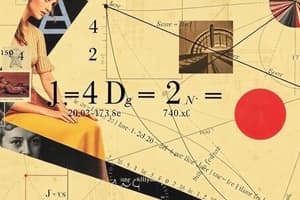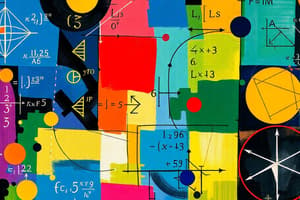Podcast
Questions and Answers
What is an example of an algebraic function?
What is an example of an algebraic function?
- f(x) = 2^x
- f(x) = log(x)
- f(x) = x^2 (correct)
- f(x) = sin(x)
What is the notation for the composition of two functions, f and g?
What is the notation for the composition of two functions, f and g?
- f(x) + g(x)
- f(x) × g(x)
- f(g(x))
- (f ∘ g)(x) (correct)
What is the range of a function?
What is the range of a function?
- The set of all possible output values of the inverse function
- The set of all possible input values of the function
- The set of all input values for which the function is defined
- The set of all possible output values of the function (correct)
What is the definition of an even function?
What is the definition of an even function?
What type of function is f(x) = 1/x?
What type of function is f(x) = 1/x?
What is the purpose of a graphical representation of a function?
What is the purpose of a graphical representation of a function?
What is the notation for the inverse of a function, f?
What is the notation for the inverse of a function, f?
What type of coordinate system is used to plot points on a graph?
What type of coordinate system is used to plot points on a graph?
What is the general form of a linear equation?
What is the general form of a linear equation?
What is the purpose of writing an equation in slope-intercept form?
What is the purpose of writing an equation in slope-intercept form?
What is the formula to calculate the distance between two points?
What is the formula to calculate the distance between two points?
What is the midpoint formula used for?
What is the midpoint formula used for?
What do the variables m and b represent in the slope-intercept form?
What do the variables m and b represent in the slope-intercept form?
What is the first step in graphing an equation?
What is the first step in graphing an equation?
What is the purpose of the distance formula?
What is the purpose of the distance formula?
What is the formula for the midpoint of a line segment?
What is the formula for the midpoint of a line segment?
What is the advantage of writing an equation in slope-intercept form?
What is the advantage of writing an equation in slope-intercept form?
What is the last step in graphing an equation?
What is the last step in graphing an equation?
Flashcards are hidden until you start studying
Study Notes
Types of Mathematical Functions
Algebraic Functions
- A function that can be expressed as a polynomial or a rational function (i.e., the quotient of two polynomials)
- Examples:
f(x) = x^2,f(x) = 1/x
Trigonometric Functions
- Functions that relate to the angles and triangles in a right triangle
- Examples:
sin(x),cos(x),tan(x)
Exponential Functions
- Functions that have a base raised to a power
- Examples:
f(x) = 2^x,f(x) = e^x
Logarithmic Functions
- Functions that are the inverse of exponential functions
- Examples:
f(x) = log(x),f(x) = ln(x)
Function Operations
Composition
- Combining two functions by applying one function to the output of another
- Notation:
(f ∘ g)(x) = f(g(x))
Inverse
- A function that reverses the effect of another function
- Notation:
f^(-1)(x)
Function Properties
Domain
- The set of all input values for which the function is defined
Range
- The set of all possible output values of the function
Even and Odd Functions
- Even function:
f(-x) = f(x) - Odd function:
f(-x) = -f(x)
Graphical Representations
Cartesian Coordinates
- A system of coordinates that uses x and y axes to plot points
Graph of a Function
- A visual representation of a function's behavior
- Can be used to identify key features such as maxima, minima, and asymptotes
Types of Mathematical Functions
- Algebraic functions can be expressed as a polynomial or a rational function.
- Examples of algebraic functions include
f(x) = x^2andf(x) = 1/x. - Trigonometric functions relate to angles and triangles in a right triangle.
- Examples of trigonometric functions include
sin(x),cos(x), andtan(x). - Exponential functions have a base raised to a power.
- Examples of exponential functions include
f(x) = 2^xandf(x) = e^x. - Logarithmic functions are the inverse of exponential functions.
- Examples of logarithmic functions include
f(x) = log(x)andf(x) = ln(x).
Function Operations
- Function composition combines two functions by applying one function to the output of another.
- Notation for function composition is
(f ∘ g)(x) = f(g(x)). - Inverse functions reverse the effect of another function.
- Notation for inverse functions is
f^(-1)(x).
Function Properties
- Domain is the set of all input values for which the function is defined.
- Range is the set of all possible output values of the function.
- Even functions satisfy the condition
f(-x) = f(x). - Odd functions satisfy the condition
f(-x) = -f(x).
Graphical Representations
- Cartesian coordinates use x and y axes to plot points.
- Graph of a function is a visual representation of a function's behavior.
- Graphs can be used to identify key features such as maxima, minima, and asymptotes.
Graphing Equations
- The general form of a linear equation is Ax + By = C, where A, B, and C are constants.
- To graph an equation, follow these steps: write the equation in slope-intercept form (y = mx + b), identify the slope (m) and y-intercept (b), plot the y-intercept on the coordinate plane, use the slope to find additional points on the line, and draw the line through the points.
Distance Formula
- The distance formula is used to calculate the distance between two points on a coordinate plane.
- The formula is: √((x2 - x1)^2 + (y2 - y1)^2), where (x1, y1) and (x2, y2) are the coordinates of the two points.
- The distance formula can be used to find the length of a line segment, the distance between two points, or the radius of a circle.
Slope-intercept Form
- Slope-intercept form is a way of writing linear equations in the form y = mx + b.
- In slope-intercept form, m is the slope (a measure of how steep the line is) and b is the y-intercept (the point where the line crosses the y-axis).
- Slope-intercept form is useful for graphing equations and identifying the slope and y-intercept.
Midpoint Formula
- The midpoint formula is used to find the midpoint of a line segment.
- The formula is: ((x1 + x2)/2, (y1 + y2)/2), where (x1, y1) and (x2, y2) are the coordinates of the two endpoints of the line segment.
- The midpoint formula can be used to find the midpoint of a line segment, or to find the coordinates of the midpoint of a line segment given the endpoints.
Studying That Suits You
Use AI to generate personalized quizzes and flashcards to suit your learning preferences.




